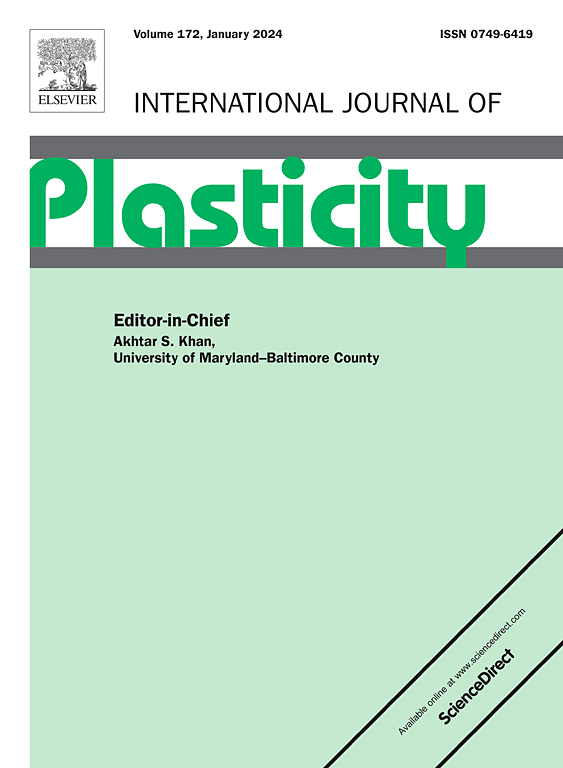Multiscale-informed irradiation growth model of Zr-Sn-Nb alloys
IF 9.4
1区 材料科学
Q1 ENGINEERING, MECHANICAL
引用次数: 0
Abstract
A systematic multiscale-informed model is developed to predict the irradiation growth behavior of Zr-Sn-Nb alloys, which considers the anisotropy and temperature dependence of both plasticity and irradiation, as well as the alloying effect of Zr alloys. This model consists of a cluster dynamics submodel to consider the kinetics of irradiation defect, an alloying effect submodel informed by atomic simulations and experiments, a microstructure transition submodel derived from discrete dislocation dynamics, and a continuous irradiation growth submodel based on crystal plasticity. It effectively captures the irradiation-induced coevolution of multiple microstructures, including point defects, mobile clusters, dislocation lines and irradiation loops on the prismatic and basal plane, as well as Nb-induced precipitates. It is suitable for high-dose irradiation conditions as it reasonably considers the transition from high-density irradiation loops to tangled dislocation network. The predicted irradiation growth strain, as well as the density and size of irradiation loops, are in good agreement with almost all the available experiments for pure Zr, Zr-Sn, Zr- Nb, and Zr-Sn-Nb alloys at different irradiation doses in the temperature range of 473 - 673 K. This work is hoped to provide a powerful tool for developing irradiation resistance cladding materials.Zr-Sn-Nb 合金的多矢量信息辐照生长模型
该模型考虑了塑性和辐照的各向异性和温度依赖性,以及锆合金的合金效应。该模型包括一个考虑辐照缺陷动力学的团簇动力学子模型、一个基于原子模拟和实验的合金效应子模型、一个从离散位错动力学推导出的微结构转变子模型,以及一个基于晶体塑性的连续辐照生长子模型。它有效地捕捉了辐照诱导的多种微观结构的共同演化,包括点缺陷、移动簇、位错线和棱柱面和基面上的辐照环,以及铌诱导析出物。它合理地考虑了从高密度辐照环到纠结位错网络的过渡,因此适用于高剂量辐照条件。所预测的辐照生长应变以及辐照环的密度和尺寸与几乎所有现有的实验结果都非常吻合,这些实验是在温度为 473 - 673 K 的范围内,对纯 Zr、Zr-Sn、Zr-Nb 和 Zr-Sn-Nb 合金进行不同剂量的辐照。
本文章由计算机程序翻译,如有差异,请以英文原文为准。
求助全文
约1分钟内获得全文
求助全文
来源期刊

International Journal of Plasticity
工程技术-材料科学:综合
CiteScore
15.30
自引率
26.50%
发文量
256
审稿时长
46 days
期刊介绍:
International Journal of Plasticity aims to present original research encompassing all facets of plastic deformation, damage, and fracture behavior in both isotropic and anisotropic solids. This includes exploring the thermodynamics of plasticity and fracture, continuum theory, and macroscopic as well as microscopic phenomena.
Topics of interest span the plastic behavior of single crystals and polycrystalline metals, ceramics, rocks, soils, composites, nanocrystalline and microelectronics materials, shape memory alloys, ferroelectric ceramics, thin films, and polymers. Additionally, the journal covers plasticity aspects of failure and fracture mechanics. Contributions involving significant experimental, numerical, or theoretical advancements that enhance the understanding of the plastic behavior of solids are particularly valued. Papers addressing the modeling of finite nonlinear elastic deformation, bearing similarities to the modeling of plastic deformation, are also welcomed.
 求助内容:
求助内容: 应助结果提醒方式:
应助结果提醒方式:


